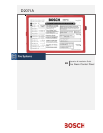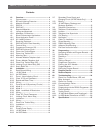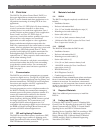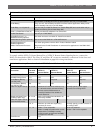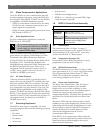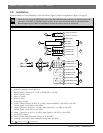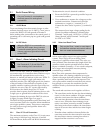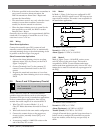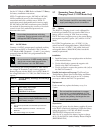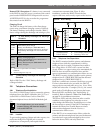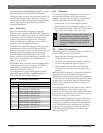
Bosch | 09/04 | 74-06200-000-F4
D2071A | Operations & Installation Guide |
1.0 Overview
The D2071A Fire Alarm Control Panel (FACP) is a
three-zone digital alarm communicator transmitter
(DACT) used in limited stand-alone applications or in
off-premises monitoring of existing FACPs in slave
applications.
Zone 1 is a Class “A” (NFPA Style D) alarm initiating
circuit. It can monitor waterflow or other alarm
initiating devices in a stand-alone application. Zone 1
can also monitor an alarm output in a slave application.
Zones 2 and 3 are Class “B” (NFPA Style A)
supervisory circuits that monitor sprinkler supervision
devices such as valve tampers in a stand-alone
application or trouble outputs in a slave application.
Primary and alternate telephone outputs allow the
D2071A to communicate to the central station or remote
station. A built-in telephone line supervision circuit with
trouble buzzer, LED, and optional Form “C” Relay
provides local telephone line trouble annunciation for
both telephone lines. The D2071A also provides an
optional Form “C” Relay output for alarm annunciation
on the alarm initiating circuit.
The D2071A is housed in a red plastic, nonconductive
enclosure that insulates the device from surrounding
circuit boards or metal surfaces. You can mount the
D2071A in fire alarm control enclosures specified in
Table 1 on page 5.
1.1 Communicator
The D2071A uses a built-in communicator to transmit
reports to a digital receiver. Two RJ31X or RJ38X jacks
connect to two separate telephone lines for primary and
alternate transmissions. The D2071A has full telephone
line seizure and complies with FCC regulations for
using the public telephone network.
You must program two receiver telephone numbers for
the D2071A. Initially, the communicator attempts to
transmit reports to the primary telephone number. If it
cannot, the communicator switches to the alternate
number. Reports are transmitted to the receiver in
binary frequency-shift keying (BFSK) format or pulsed
fast single round format. The communicator only
accepts the 2300 Hz acknowledgment tone. It is
compatible with most major digital receivers that accept
the BFSK or Pulsed Fast Single Round format, and
generates a 2300 Hz acknowledgment tone.
1.2 RFI and Lightning Protection
The D2071A resists radio frequency interference (RFI)
and high-voltage surges common to lightning areas.
Spark gaps and metal oxide varistors (MOVs) give the
D2071A additional electrical protection.
1.3 Materials Included
1.3.1 D2071A
The D2071A is shipped completely assembled and
includes:
• Installation literature
• End-user information label
• 15 in. (2.7 cm) double-sided adhesive strips (2)
• Mounting screws and washers (2)
• Strain relief cable tie (1)
• 32 in. (81 cm) dual connector battery leads
• 1.8 kΩ end-of-line (EOL) resistors for Zone 2 and
Zone 3 supervision circuits (2)
1.3.2 D2071AC
The D2071AC Kit include the D2071A and:
• Installation literature
• End user information label (1)
• Mounting screws and washers (2)
• Strain relief cable tie (1)
• 32 in. (81 cm) dual connector battery leads
• 1.8 kΩ EOL resistors for Zone 2 and Zone 3
supervision circuits (2)
• D4103R Enclosure (1)*
• D161 Telephone Cords (2)
• Conduit support washers (2)
* The D4103R includes a D2002 Mounting Plate and a Basler
Electric Transformer (Model A9115 [P/N: 58-06306-000])
installed in the enclosure. This transformer is Underwriters
Laboratories, Inc. (UL) recognized, Class II rated for 20 VA at
12 VAC. It uses pigtails to hard wire directly to a 110 VAC or
120 VAC power source.
1.4 Required Materials
Table 1 lists additional parts necessary to install the
D2071A.
1.5 Listings and Approvals
UL lists the D2071A DACT under UL Standard 864,
Control Units Fire Signaling Systems and 1635, Digital
Alarm Communicators for NFPA 72 Central Station
Signaling Service and NFPA 72 Remote Station
Signaling Service. Install the D2071A according to NEC
Article 760 of the NFPA 70. Additional approvals are
Factory Mutual (FM), California State Fire Marshal
(CSFM), and New York City-Material Engineering
Association (NYC-MEA).
1.0 Overview



